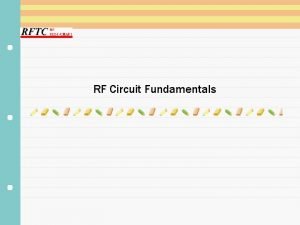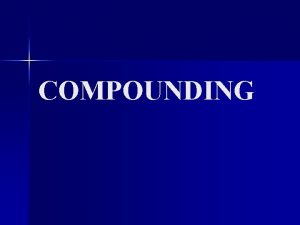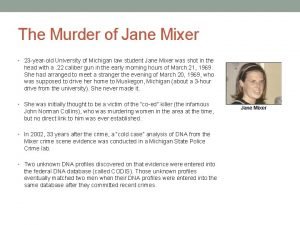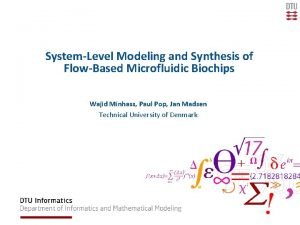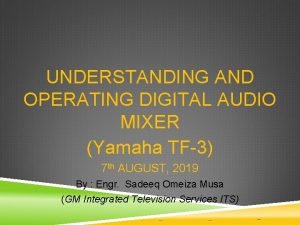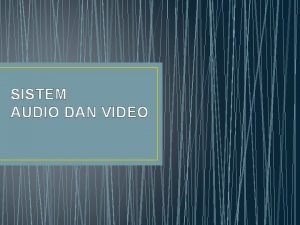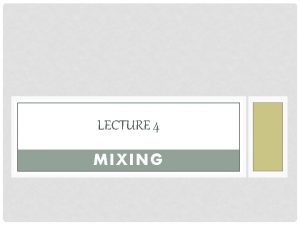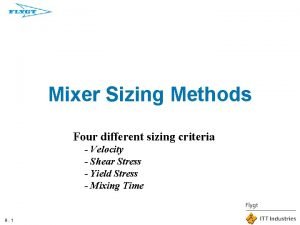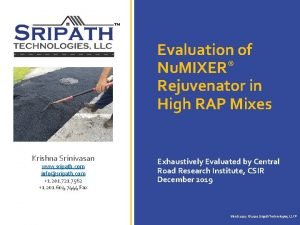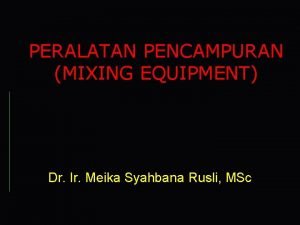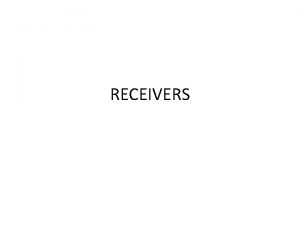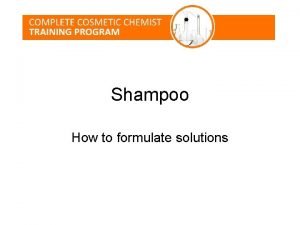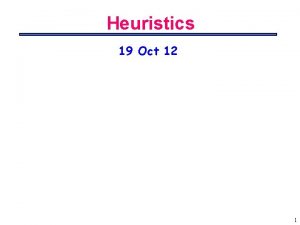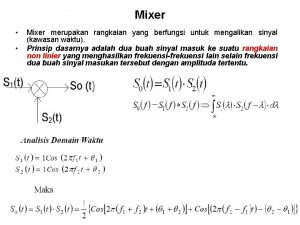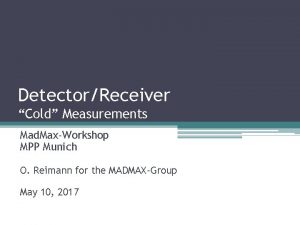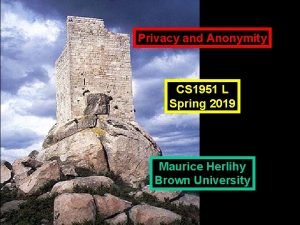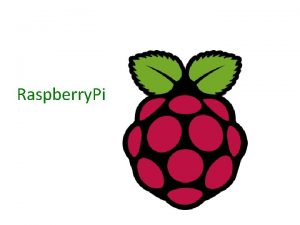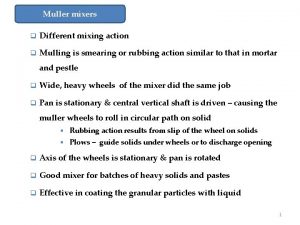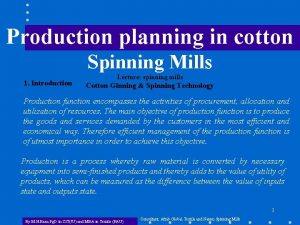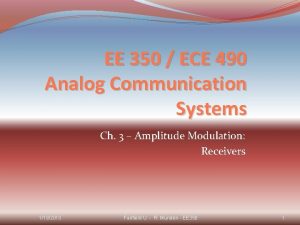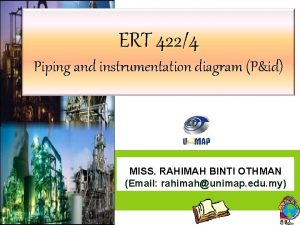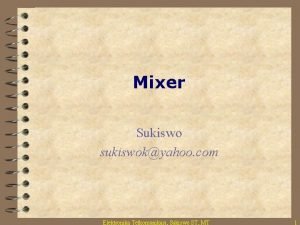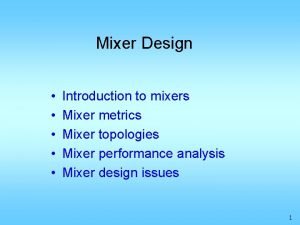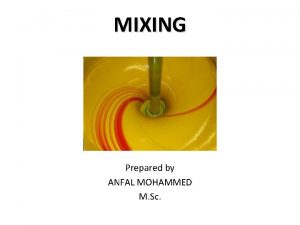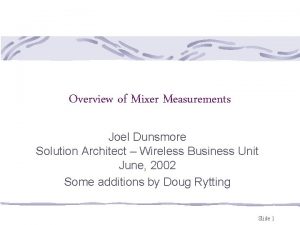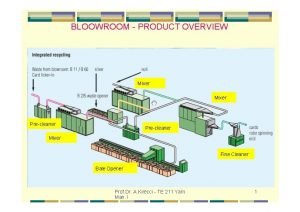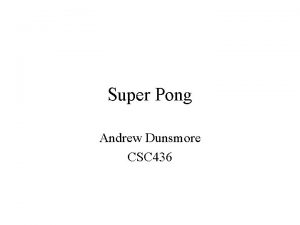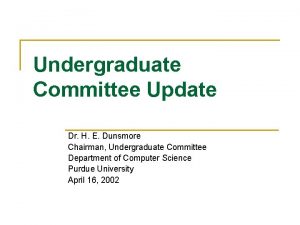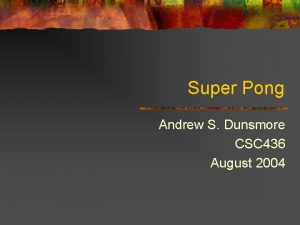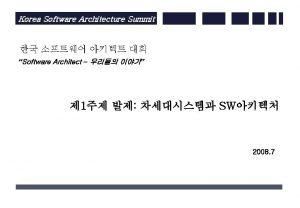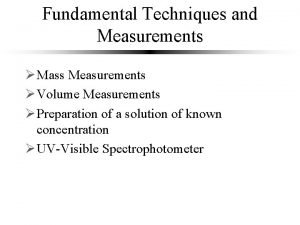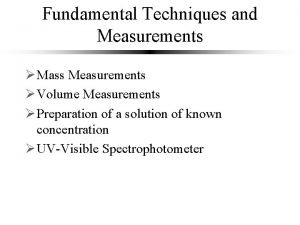Overview of Mixer Measurements Joel Dunsmore Solution Architect









































- Slides: 41

Overview of Mixer Measurements Joel Dunsmore Solution Architect – Wireless Business Unit June, 2002 Some additions by Doug Rytting Slide 1

Agenda Mixer Characteristics Traditional Mixer Measurement Techniques New Concepts in Mixer Characterization Test Results Comparison & Complete Mixer Measurements Image Mixer Appendix 2

Mixer Characteristics Conversion Measurements Magnitude Response Phase Response Group Delay Input Match Output Match Isolation Spurious Mixing Products 3

Mixer Conversion Measurements power level Conversion gain is the ratio of desired-image power to applied input power Since the input and output frequencies are not the same, the definition of conversion phase can be confusing. We define the conversion phase as the phase shift of the output, were it synchronously reconverted to the input frequency with an ideal (zero phase shift) converter. Conversion loss frequency 4

Agenda Mixer Characteristics Traditional Mixer Measurement Techniques New Concepts in Mixer Characterization Test Results Comparison & Complete Mixer Measurements Image Mixer Appendix 5

Measuring Conversion Phase and Group Delay: AM Technique Gd = - fe ¸ (360 * fmod) Phase Detector AM Modulator R F Measure phase between two demodulated signals LO Swee p DUT fmod 6

Measuring Conversion Phase and Group Delay: FM Technique Gd = - fe ¸ (360 * fmod) Phase Detector Demod Frequency Modulator R F Demod Measure phase between two demodulated signals LO Swee p DUT fmod 7

Up/Down Conversion with Equal Mixers Requires Image filter Requires two matched mixers Mixers must be reciprocal Assume that Mixer 1 = Mixer 2 Must remove filter effects Must have accessible (or identical) LOs 8

Three Mixer Technique Described by Clark, et al, in Microwave Journal, Nov 1996* Requires 3 mixers, One of which MUST be reciprocal Requires filtering of images Does not correct for mismatch between mixers Must remove filter effects Mxr B Mxr A Mxr C Mxr B *US Patent 6, 064, 694 9

Agenda Mixer Characteristics Traditional Mixer Measurement Techniques New Concepts in Mixer Characterization Test Results Comparison & Complete Mixer Measurements Image Mixer Appendix 10

New Concept in Mixer Characterization (Patented) Requires a Reciprocal Calibration Mixer Requires an image filter for Calibration Mixer No other restrictions Currently supported in the Agilent PNA family External or Internal LO source Ref Standards IF Filter 11

Mixer Calibration: Only calibrated reflection measurements are made. RF signal is reflected off the input of mixer: does not change with load. IF + signal is converted and then reflected off image filter: does not change with load IF – signal is converted, passes through the IFfilter reflects off load: Changes With Load 12

Measure Mixer+Filter and Open 13

Measure Mixer+Filter and Open 14

Measure Mixer+Filter and Short (with Open still shown) Short Open 15

Measure Mixer+Filter and Short 16

Measure Mixer+Filter and Load (with Open and Short still shown) Short Load Open 17

Measure Mixer+Filter and Load 18

From the corrected measurements a 1 -port error model is extracted By Definition, S 11 = EDF, also called D ESF = Mixer S 22, also called M ERF = Mixer S 21 * Mixer S 12; Mixer S 21 is also called T 1 Mixer S 12 is also called T 2 Error terms include effects of filter and mixer 19

Calculate T 1(mixer S 21) Take the square root of ERF (not so easy) Mag of mixer S 21 is easy Phase of mixer S 21 is more difficult Complex phase has two roots To choose the proper root: 1. 2. 3. 4. 5. Un-wrap phase Use delay to project DC phase Offset phase by DC phase (assume phase = 0 at DC) Divide phase by 2 Re-wrap phase (easy, express in polar form) We call this result T 1 which is also equal to T 2 20

If your mixer is reciprocal: Done! If not, you can use the reciprocal mixer to calibrate a VNA Set up a VNA with Up/Down converter Step One: Using normal VNA techniques, obtain ERF, ESF, and EDF (all at RF Frequency), and ELF (at IF Frequency) Calibration Planes 21

Step Two: Measure the uncorrected response of the cal mixer, S 21 M 1 Place calibration mixer in path, and measure S 21 M 1 Calculate ETF from the known mixer terms, error terms, and S 21 M 1 22

Download cal terms and turn on 2 -port cal During calibration ETF is corrected for source match, mixer input match, mixer output match, and load match. Also ERF, ESF, EDF and ELF were calculated at the VNA ports. ELR, ESR, EDR terms are set to 0 and ETR and ERR are set to 1 since S 12 and S 22 are not measured. Provides an input-match-corrected transmission and reflection measurement. Mixer output-match and reverse-transmission not measured. Allows real time vector measurements of mixer. 23

Agenda Mixer Characteristics Traditional Mixer Measurement Techniques New Concepts in Mixer Characterization Test Results Comparison & Complete Mixer Measurements Image Mixer Appendix 24

Comparison Measurement: Mixer+Airline Mixer with Airline and vector cal: Gray Trace Mixer with Airline, normalization: Blue Trace 25

Calibration Mixer Characterization: Amplitude Compared with Power Meter Measurements Mixer Measured as up and down converter, using power meter measurements. Black trace is the average of up/down conversion Mixer Measured as up and down converter, using the new method 26

Calibration Mixer Characterization: Phase response and Group Delay Phase Response of Mixer, (Measured as up and down converter) Group Delay Response of Mixer, (Measured as up and down converter) 27

Agenda Mixer Characteristics Traditional Mixer Measurement Techniques New Concepts in Mixer Characterization Test Results Comparison & Complete Mixer Measurements Image Mixer Appendix 28

Comparison Mixer Measurements Characterization of calibration mixer Mixer comparison network analyzer Test Path Ref Path or Golden-Mixer Test-Mixer After Cal 29

Comparison Mixer Measurements 30

Complete Mixer Characterization Int Source Int LO Meas S 11 RF RF b 0/a 0 S 21 RF IF b 3/a. R S 12 IF RF b 0/a. R S 22 IF IF b 3/a 3 31

Summary Common mixer measurement techniques lack the ability to accurately measure phase or delay of mixers. A new technique, based on reflection measurements, resolves this problem, and provides accurate and repeatable measurements of reciprocal mixers for both magnitude and phase response. Mixers characterized in this way can be used to calibrate test systems, such that non-reciprocal mixers can be measured for phase and absolute delay. Comparison mixer characterization was described. Complete mixer characterization approach was proposed. 32

Agenda Mixer Characteristics Traditional Mixer Measurement Techniques New Concepts in Mixer Characterization Test Results Comparison & Complete Mixer Measurements Image Mixer Appendix 33

Consider “Hi-side” LO mixers For image mixers note the frequency sweep reversal, which implies phase conjugation 34

Mixer Characterization for an Image Mixer: Very poor result for extracted S 22, but only when use characterized (Ecal) devices (not mechanical standards) S 22 from VNA S 22 from Mixer char. 35

Image Mixer Definition of Waves 36

New Rule for Image Mixers a. IF b. IF a. IM a. IF b. IM b. IF a. IM b. IM SIF* a. LO 37

Take the Conjugate of the Load Simple rules for dealing with moving a reflection from the output of an image mixer to its input 38

S 21 Characterization With and without an added airline and without using the conjugate of the load 39

S 22 Characterization Shows the proper response when extracted with the conjugate load technique Precision Match IF IM LO 40

Image Mixer Summary Common mixer measurement techniques lack the ability to accurately measure phase or delay of mixers A previous technique based on reflection measurements resolves this problem, and provides accurate and repeatable measurements of reciprocal mixers for both magnitude and phase response, but fails to give the correct response for “image” mixers. That technique is modified to account for the phase reversal of image mixers, namely by using the conjugate of the reflection loads. A theory of image mixer conversion parameters has been introduced, which predict and account for the phasereversal effects. Several measurements verify the new technique, and underlying theory 41
 Joel dunsmore
Joel dunsmore Itsc solution architect
Itsc solution architect Partial vapour pressure
Partial vapour pressure Entolator mixer
Entolator mixer Subharmonic mixer
Subharmonic mixer Planetary mixer definition
Planetary mixer definition Jane mixer killer
Jane mixer killer Synthesis
Synthesis Mixer yamaha tf3
Mixer yamaha tf3 Digital logic controller
Digital logic controller Pengertian sistem audio
Pengertian sistem audio Propeller mixer definition
Propeller mixer definition Mixer sizing calculations
Mixer sizing calculations Numixer
Numixer M1970v
M1970v Muller mixer
Muller mixer Identity mixer
Identity mixer Disadvantages of trf receiver
Disadvantages of trf receiver Shampoo characteristics
Shampoo characteristics Helical ribbon mixer
Helical ribbon mixer Rangkaian mixer
Rangkaian mixer After applying dumpster doc when should it be rinsed
After applying dumpster doc when should it be rinsed Sis mixer
Sis mixer Ethmixer
Ethmixer Posh
Posh Raspberry outline
Raspberry outline Muller mixer diagram
Muller mixer diagram Belle mixer
Belle mixer Self excited mixer
Self excited mixer Hic in p&id
Hic in p&id Example tongue twisters
Example tongue twisters Eifs mixer
Eifs mixer Dual gate mosfet rf amplifier
Dual gate mosfet rf amplifier Concrete mixer machine
Concrete mixer machine Double balanced mixer
Double balanced mixer Double cone blender advantages and disadvantages
Double cone blender advantages and disadvantages Audio visualizer arduino
Audio visualizer arduino Chris jordan architect
Chris jordan architect Dpm architect
Dpm architect John crawford intel
John crawford intel Enterprise architect deployment diagram
Enterprise architect deployment diagram Kenneth turner architect
Kenneth turner architect




